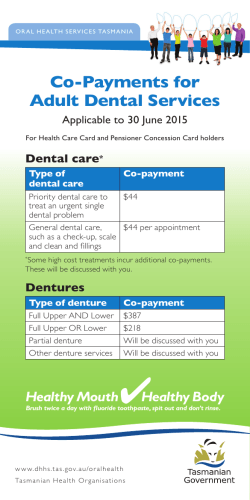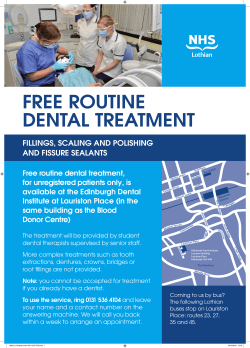
frequency and severity of dental fluorosis among school children in
Original Article FREQUENCY AND SEVERITY OF DENTAL FLUOROSIS AMONG SCHOOL CHILDREN IN GADAP TOWN, KARACHI ABID MOHSIN, BDS, MPH SAMAN HAKEEM, BDS, FCPS 3 ABDUL HAKEEM ARAIN, BDS, DPD 4 TAHIR ALI, BDS, MPhil 5 DAUD MIRZA, BDS, MSc 1 2 ABSTRACT The objective of the study was to determine the prevalence and severity of dental fluorosis among primary school children. This was a cross-sectional study. Clinical examination was conducted by calibrated examiners. Dean’s fluorosis index as recommended by WHO (1997) was used to determine severity of dental fluorosis. The burden of the disease in the community was also calculated through Community Fluorosis Index. Three hundred fifteen 6- to 15 year-old school children (219 boys and 96 girls) comprised the sample. Some high school age children who were in primary section were also included in the study. The prevalence of dental fluorosis was found to be 53.33 % in the study sample. The difference among genders was found which did not increase with age. In males of age groups 6-9, 10-12, 13-15 years CFI values of 1.09, 1.11 and 1.39 were found respectively. Whereas in females of age groups 6-9, 10-12, 13-15 years lower CFI values of 0.64, 0.43 and 0.55 were recorded respectively. This study can be taken as a baseline study for a further epidemiological research on dental fluorosis in this study area. The data can be utilized by public health organizations and dentists to evaluate risk factors and devise preventive strategies. Key words: Fluorosis, child, dentition. INTRODUCTION Normal growth and development require fluorine as an essential element. In particular, fluoride’s role in preventive dentistry is very important since it garners cariostatic potential.1,2 This cariostatic potential may be converted into dental and skeletal fluorosis if taken excessively. Dental fluorosis is a hypo mineralization of enamel and dentine produced by chronic or excessive ingestion of fluoride during tooth development process.1,2,3,4 The severity of dental fluorosis depends on the fluoride intake during tooth formation.5,6 The clinical enamel defects vary from fine white lines to severe chalky or opaque enamel, which may get discolored and are easily broken down after eruption. The important problems Correspondence: Dr Saman Hakeem Mailing Address: 41-Z/B, Block 6, PECHS, Karachi E-mail: [email protected] Cell: +92300-9257062 1 Consultant Dental Surgeon & Assistant Professor, Abdullah Dental Surgery, Karachi, Pakistan. 2 Assistant Professor & HoD, Deptt. Of Prosthodontics, Bahria University Medical and Dental College, Karachi, Pakistan. 3 Consultant Dental Surgeon & Associate Professor, Abdullah Dental Surgery, Karachi, Pakistan. 4 Assistant Professor, Deptt. of Periodontology, Bhittai Dental and Medical College, Mirpurkhas Pakistan. 5 Assistant Professor, Deptt. of Oral Pathology, Bahria University Medical and Dental College, Karachi, Pakistan. Received for Publication: Accepted: October 29, 2014 November 26, 2014 Pakistan Oral & Dental Journal Vol 34, No. 4 (December 2014) due to dental fluorosis are discoloration and the loss of outermost enamel.7 The enamel discoloration is often so unsightly that it causes psychological problems in patients8 whereas the loss of enamel is easily affected with dental caries. These may have a negative impact on personal wellbeing. There are some communities where drinking water contains high fluoride. This study attempts to determine the prevalence and its severity. This study also calculated the community fluorosis index (CFI) among the study sample of primary school children in Gadap Town, Karachi. This data and statistics regarding dental fluorosis can be used as baseline for further studies. It may also help the public health organizations and community services to plan and devise much needed preventive strategies. METHODOLOGY This was a cross-sectional observational study. It was conducted in the rural areas of Gadap Town, Karachi. The sample comprised of 315 school children aged 6-15 years. The subject’s residency in the study area since birth was confirmed. Consent and approval from concerned school authorities were obtained. Consent forms were sent to prospective subject’s parents to be duly signed before their inclusion in the study. No dropouts were reported. Three trained dental surgeons performed oral exam684 Frequency and Severity of Dental Fluorosis ination using disposable examination sets comprising of dental mirror, probe and tweezer. The examination was done in day light on a chair. The operators were calibrated by a clinical calibration exercise before the research was undertaken. The presence and severity of dental fluorosis was documented in the devised proforma. The severity was scored by Dean’s Fluorosis index (1942) which follows the WHO (1997) criteria.9 This index gives six degrees of severity starting from normal, questionable, very mild, mild, moderate to severe. It involved the rating of each tooth in the mouth according to six categories of Dean’s index. The score was based on the severest form of dental fluorosis for two or more teeth in the mouth. The last four categories of Dean’s index was considered as fluorosis. Community Fluorosis Index (CFI) index10 was used to calculate the public health significance of the disease. It was calculated by summation of scores of dental fluorosis as recommended by Dean. Then dividing the result by the total sample size. The public health significance of CFI is categorized into six value ranges of 0.0-0.4 taken as negative, 0.4-0.6 as borderline, 0.6-1.0 as slight, 1.02.0 as medium, 2.0-3.0 as marked and finally 3.0-4.0 value range as very marked. RESULTS The sample comprised of 315 schoolchildren attending primary school at Gadap Town, Karachi. Out of these 315, 219 (69.5%) were boys and 96 (30.5%) were girls. (Table 1) The frequency of dental fluorosis in the sample was found to be 168 with a percentage of 53.33%. It was more prevalent among boys than girls with 61.64% and 34.38% respectively. Male to female ratio was approximately 4:1. The frequency of dental fluorosis was 78 (49.37%) in 6-9 age group, 54 (55.10%) in 10-12 age group and 36 (61.01%) in 13-15 age group (Table 2). Most of the affected subjects had very mild fluorosis that is 81 (25.71%) while only 03 (0.95%) subjects presented with severe fluorosis. Severity of dental fluorosis according to age and gender is given in Table 3. Community Fluorosis index (CFI score) ranged from borderline (0.43) to slight (0.64) in females while male presented with medium (1.09-1.39) in different age groups (Table 2). DISCUSSION Fluoride has been used as preventive measure to control caries in water supplies. According to WHO 1984 report, an optimal level of 0.5 to 1.0 ppm is sufficient to prevent caries. In Pakistan, Pakistan Council of Research and Water Resources (PCRWR) conducted a National Water Quality Monitoring Programme (20012006).11 In this survey fluoride considered as one of the factors to affect quality of water was found to be 5% in surface soil and groundwater. Moreover, Karachi was established as a high fluoride area. Similarly Khan AA et al (2002)12 also studied the fluoride content in water sources in Pakistan. The authors concluded that as a whole, 84% of the water sources have less than 0.7 ppm fluoride content. In Sindh, Thar was identified as a high risk area with fluorosis as a community health problem. The effects of level of fluoride in water are influenced by climatic temperatures as well. According to Pakistan’s climate which is approximately 84 degrees TABLE 1: DISTRIBUTION OF SUBJECTS ACCORDING TO AGE AND GENDER n=315 Age (years) Male Female Total (n) % (n) % 6-9 109 68.98 49 31.02 158 10-12 70 71.43 28 28.57 98 13-15 40 67.79 19 32.21 59 Total 219 69.52 96 30.47 315 Key: n = no of children TABLE 2: FREQUENCY OF DENTAL FLUOROSIS AND CFI ACCORDING TO AGE AND GENDER n = 168 Frequency of fluorosis Variable n=168 Age Groups CFI score Percentage: 53.33 Mean: 0.84 M F M F M F 6-9 60 18 44.44 54.54 1.09 0.64 10-12 45 9 33.33 27.28 1.11 0.43 13-15 30 6 22.22 18.18 1.39 0.55 135 33 100 100 Total Key: n = subjects M = male F = female CFI = community fluorosis index Pakistan Oral & Dental Journal Vol 34, No. 4 (December 2014) 685 Frequency and Severity of Dental Fluorosis TABLE 3: DISTRIBUTION OF SUBJECTS ACCORDING TO SEVERITY OF DENTAL FLUOROSIS n = 315 Age Normal Questionable Very mild Mild Moderate Severe M F M F M F M F M F M F 6-9 28 22 21 9 27 9 24 9 9 0 0 0 158 10-12 19 19 6 0 24 6 12 3 9 0 0 0 98 13-15 7 10 3 3 12 3 15 3 0 0 3 0 59 Total 54 51 30 12 63 18 51 15 18 0 3 0 105 42 81 66 18 3 (33.33%) (13.33%) (25.71%) (20.95%) (5.71%) (0.95%) Key: n = no of subjects M = male Total 315 F = female Fahrenheit, WHO recommends 1.5mg/L as a safe level.12 Moreover, high fluoride levels in water is correlated to high levels of fluoride in blood serum with a positive dose response.13 Qayyum et al13 studied this aspect and inferred that, in endemic areas there is greater risk of fluorosis through water contamination. Globally, frequency of fluorosis ranges from a meager 8.53%14 to a staggering high of 69.84%.15 Even within countries, the prevalence of fluorosis varies between different geographical locations. In India which is Pakistan’s neighbor with similar geographical and climatic conditions, the prevalence of fluorosis varies from 46% in Pradesh16 to 69.84% in Rajasthan.15 Higher frequencies are seen in endemic areas. Same stands true for Pakistan. Endemic areas with high fluoride content of water above 1.5mg/L constitute around 16% of water sources.12 Gadap Town being an area where water source is basically groundwater and is considered an endemic area. This study also proved this notion because more than half of the subjects presented with some form of fluorosis. Thereby, these results are consistent with other studies done in endemic areas of Pakistan like Mangamandi and Kalat division.11,12 Another study which showed almost the same results with 60% fluoride affected population was done in urban population near Quetta.17 It was a case control study with control group taken from a non-endemic areas, the peri urban population which had a different water source. Comparatively, the prevalence was more in urban population which have groundwater source, though the results were not statistically significant. As opposed to this, a study conducted in a teaching hospital in Lahore found only 12% fluorosis.18 The authors claimed that most of the patient pool was from adjoining areas including Patoki, Kasur, Mangamandi and Kot Radha Kishan. The reason for such a less frequency may be due to sampling technique, the patient pool being not representative of the population. Then there are studies in literature which have cited a very high prevalence of fluorosis around 85% to 98% in Mianwali and Mardan respectively.19 Apart from the high fluoride value in groundwater in these areas, the authors also cited greater tea consumption to be a possible Pakistan Oral & Dental Journal Vol 34, No. 4 (December 2014) risk factor for this very high fluorosis prevalence even for any endemic area in Pakistan. This study may have under estimated fluorosis since only one school was examined. Further studies with a better study design and sampling technique may provide more accurate results. Albeit, this study has identified Gadap town to have a significant dental health problem in the form of fluorosis which not only impacts the aesthetics but also the self-esteem of an individual especially for children who may undergo embarrassment and peer pressure.20 The results of this study are also consistent with studies done in primary school children of rural areas of Haryana21 and Tamil Nadu.22 The mild differences in prevalence is due to different levels of fluoride in different areas. Other possible reasons may be the differences in climate, dietary habits, usage of fluoride dentrifices, dust and fumes from adjoining aluminium industry19 if applicable which have not been considered in any of the above mentioned studies. This study reported greater prevalence of fluorosis in males than females. Marwat et al20 also found the same results. Most of the studies recorded no gender difference like in Haryana21 and Tamil Nadu22, as well as in rural Tanzania.22 In contrast, a study conducted in Kerala23 and Lahore18 showed greater prevalence in girls than boys. The difference in the results may be due to lesser number of girls in schools than boys. Since the current study was conducted in a school, it may have missed the fairer sex in the sampling pool. Still, literature does not cite any established reason for greater prevalence in males.22 Many studies have shown increasing frequency of fluorosis with increasing age. A study conducted in rural communities of Brazil24 cited that greater exposure to fluoride with age leads to increase in risk of fluorosis. Saravanan et al22 deliberated it in the light of enamel developmental stage. He considered that the enamel of permanent teeth are exposed to fluoride for a greater time period in the womb since it is thicker than primary teeth. The present study didn’t give a clear predilection of fluorosis with increasing age, albeit, all the cases of severe fluorosis were recorded in 13 to 15 years age 686 Frequency and Severity of Dental Fluorosis group. Most of the cases presented with very mild fluorosis according to Dean’s Fluorosis Index. The severity may have been underestimated since this study was primarily done in mixed dentition and a lesser sample size of 13 to 15 age group. However, the reasons need to be identified in a different study assessing the permanent dentition as well. Furthermore, severity of fluorosis needs to be associated with fluoride level in water source which was not done in this study. However, the results of this study are consistent with other studies done globally in Brazil24, India22 and Mexico25 which also revealed lesser cases of objectional fluorosis. This study reported a CFI score in the category of borderline except for slight for females in 6-9 age group. This can be inferred as a significant public health problem in the researched area. According to Lamson and Galagan26 public health significance is directly related to fluoride level in water. Only three cases out of 168 had severe fluorosis in 12-15 age group, thus the CFI score in the category of borderline. The severity of fluorosis may have been underestimated since 12 – 15 year olds in this sample were very few. Therefore, this age group was not represented properly in the sample. Further studies need to be done in adolescents and teenagers which may reveal increased severity of fluorosis in population of Gadap Town. Thereby, the burden of the disease may be greater in this area. Moreover, the fluoride level in water also needs to be analysed with other risk factors of fluorosis. However, this study is an attempt to provide a platform for identifying further research questions in the area. This data can be utilized as a preliminary record for a well-designed epidemiological study in this endemic area. 7 Franzolin SB, Goncalves A, Padovani CR, Francischone LA, Marta SN. Epidemiology of fluorosis and dental caries according to different types of water supplies. Ciencia & Saude Coletiva 2010;15:1841-47. 8 Belkhir MS, Douki N. A new concept for removing dental fluorosis stains. J Endodon 1991;6:28-92. 9 World Health Organization. Oral health surveys: Basic methods. 4th ed. World Health Organization: Geneva;1997. CONCLUSION Within the limitations of the study, it can be concluded that Gadap Town has a significant burden of dental fluorosis with more than half of the population having this disease. Most cases were of very mild category. 19 Siddiq K, Dost S, Naseem A, Arshad A, Attaullah. Prevalence of dental fluorosis in Mianwali and Mardan. JCDSA 2011;1:106-09. REFERENCES 10 Murray JJ, Rugg-Gunn AJ, Jenkins GN. Fluoride in caries prevention.3rd Ed. Butterworth-Heinemann Ltd:Oxford;1991. p225-232. 11 Tahir MA, Rasheed H. Fluoride in the drinking water in Pakistan and the risk of crippling fluorosis. Drink. Water Eng. Sci. 2013; 6:17-23. 12 Ayyaz AK, Whelton H, O’Mullane D. A map of natural fluoride in drinking water in Pakistan. Int dent J 2002;52(4):291-97. 13 Qayyum M, Waheed Uz Z, Ahmad B, Ahmad M, , Rehman R. Comparative study of fluoride concentration in human serum and drinking water in fluorinated endemic and non endemic areas of Pakistan. J Chem Soc Pak 2013;35(3):1025-28. 14 Azevedo MS, Goettems ML, Torriani DD, Demarco FF. Factors associated with dental fluorosis in school children in Southern Brazil. A cross sectional study. Braz Oral Res 2014; 28(1):1-7. 15 Sarvaiya BU, Bhayya D, Arora R, Metha DN. Prevalence of dental fluorosis in relation to different fluoride levels in drinking water among school children in Sarada Tehsil of Udaipur District, Rajasthan. J Indian Soc Pedod Prev Dent 2010;30(4):317-22. 16 Narwaria YS, Saksena DN. Prevalence of dental fluorosis among primary school children in rural area of Kerara Block, Madhya Pradesh. 17 Ahmed A, Naseer H, Baloch M. Prevalence of fluorosis among children aged 12 years living in urban and peri urban areas of Quetta District, Balochistan. Medical Forum Monthly 2013;24(6):86-88. 18 Rizwan S, Rizwan M, Naveed A, Ahsan W. Incidence of dental fluorosis among the patients visiting the University of Lahore Dental College/ Hospital: A study. Pak Oral Dent J 2010;30(1):224-28. 20 Marwat HJ, Khan MS, Qureshi WR, Mahmood MA. Dental fluorosis- An orthodontic adhesive challenge.Pak Oral Dent J 2010;30(1):123-26. 21 Singh AA, Birsingh, Kharbanda OP, Shukla DK, Goswani K, Gupta S. Dental fluorosis in rural school children from Haryana: A brief report. Indian J Prev Soc Med 2001;32:113-15 22 Saravan S, Kalyani C, Vijayarani MP, Jayakodi P, Felia AJW, Nagarajan S et al. Prevalence of dental fluorosis among ptimary school children in rural areas of Chidabaram Taluk, Cuddalore district, Tamil Nadu, India. Indian J Community Med 2008; 33(3):146-50. 1 Buchel K, Gerwig P, Weber C, Minnig P, Wiehl P, Schild S et al. Prevalence of Enamel Fluorosis in 12-year-Olds in two Swiss Cantons. Research and Sci 2011;121:652-56. 2 Jeminez-Farfan MD, Hernandez-Guerrero JC, Jaurez-Lopez LA, Jacinto-Aleman LF, Fuente-Hernandez J. Fluoride consumption and its impact on oral health. Int. J. Environ. Res. Public Health 2011;8:141-60. 3 Ferriera EF, Vargas AMD, Castilho LS, Velasquez LNM, Fantinel LM, Abreu NHMG. Factors associated to endemic dental fluorosisin Brazilian rural communities. Int. J. Environ. Res. Public Health 2010;7:3115-28. 24 Ferreira FF, Vargas AMD, Castilho LS, Velasquez LNM, Fantinel LM, Abreu MHNG. Factors associated with endemic dental fluorosis in Brazilian rural communities. Int J Environ Res Public Health 2010;7(8):3115-3128. 4 Den Besten PK. Machanism and timming of fluoride effects on developing enamel. J public Health Dent 1999;59:247-51. 5 Yue B, Jiang-Yuan Z, Yue-Jin Y, Bo Y, Hui H, Gang W et al. Serum calciotropic hormone levels and dental fluorosis in children exposed to different concentrations of fluoride and iodine in drinking water. Chinese medical Journal 2010; 123(6): 675-79. 25 Garcia Perez A, Irigoyen- Camacho ME, Borges-Yanez A. Fluorosis and dental caries in Mexican school children residing in areas with different water and fluoride concentrations and receiving fluoridated water. Caries Res 2013;47(4):299-308. 6 23 Gopalakrishan P, Vasan RS, Salma PS, Nau KS, Thankappan KR. Prevalence of dental fluorosis and associated risk factors in Alappuzha district, Kerala. Natl Med J India 1999;12(3):99-103. 26 Galagan DJ, Lamson GG. Climatic and endemic dental fluorosis. Public Health Rep. 1953 May; 68(5): 497–508. Horowitz HS. Indexes for measuring dental fluorois. J Public Health Dent 1986;46:179-83. Pakistan Oral & Dental Journal Vol 34, No. 4 (December 2014) 687
© Copyright 2025









